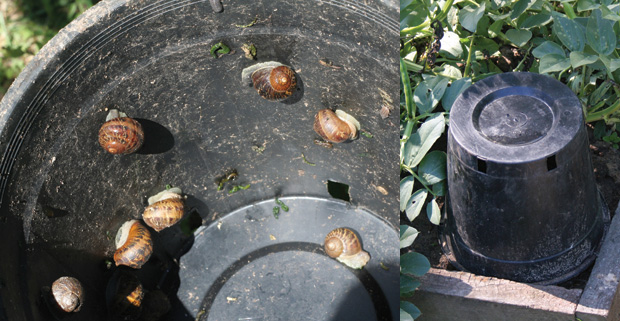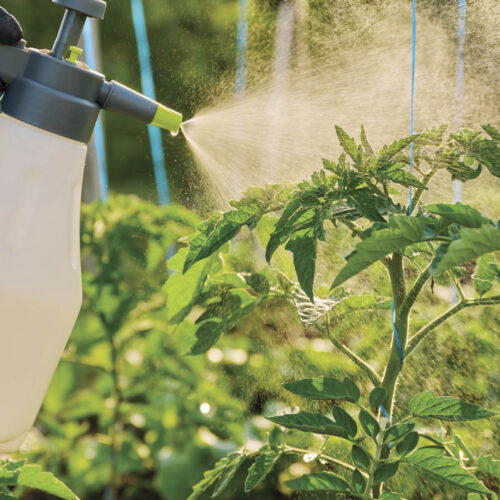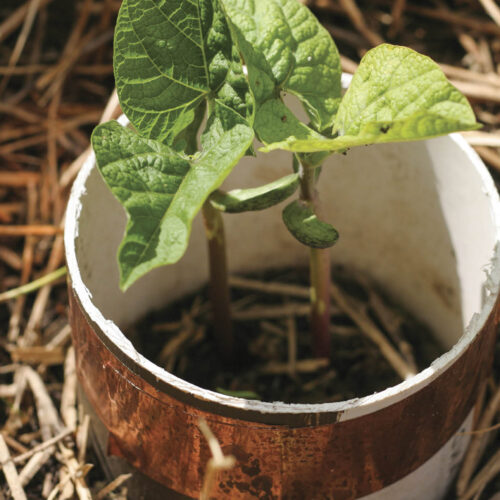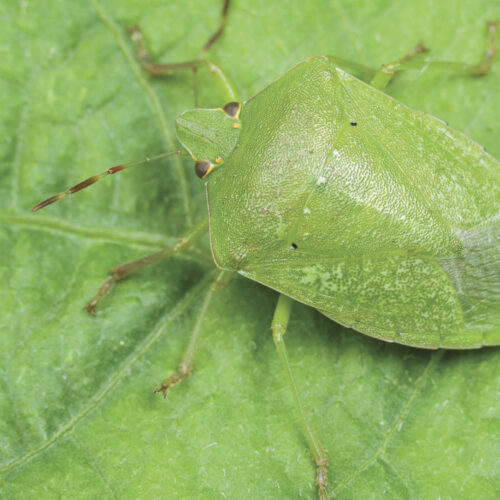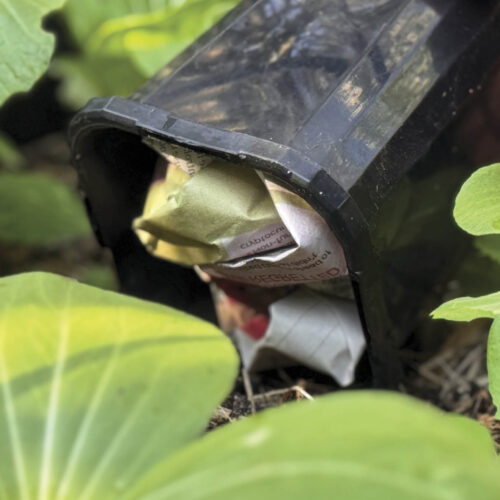On the snail trail
2011-07-31T22:46:26+10:00
PENNY WOODWARD goes to town on snails and slugs, testing a wide variety of methods for getting rid of these intriguing but troublesome pests.
Snails, snails and more snails! Our spring, summer and autumn were very wet and as a result snail numbers increased dramatically. I seemed to find them in every dark corner and under every leaf. And every time I planted out a seed or seedling the fresh, succulent green leaves would provide supper for a snail. Even quite well-established plants were disappearing under the onslaught. I had to do something about it.
Over time I tried every recommended remedy, each with only limited success. However, I finally came up with a combination of solutions that seems to be keeping the numbers under control and protecting vulnerable plants. These tactics also work for slugs. This is the story of my private war waged, often under cover of darkness, on snails.
Snail facts
I started with the old maxim of ‘know thine enemy’ and discovered that Australia has about 70 introduced species of land and freshwater snails and slugs, and many thousands of native snails, with new ones being discovered fairly regularly. It turns out that just about all our garden pest snails are introduced – so I’ve decided it is okay to kill them!
Dr John Stanisic, who has recently completed the first book on these intriguing creatures (Australian Land Snails Volume 1) revealed on ABC TV’s Catalyst* that although native snails may be numerous – and some rather large – they live mainly in rainforests and usually on decaying matter. One of the largest of the natives is the giant panda snail that lays eggs the size of small birds’ eggs.
If you are not sure whether you have a pest species, the introduced snails generally have two pairs of tentacles while the natives have only one pair.
The garden snail, Helix aspersa, was accidentally introduced from Europe and is found in cities around the world. They can take two years to reach full size, are hermaphrodites (are both male and female) but still need two snails to mate. Eggs are laid into damp soil and will take about two weeks to hatch.
Snails need dampness to thrive and when it gets too dry they will retreat into their shell and cover the entrance with a thin barrier known as an epiphragm. In this state of hibernation they can last for months without water. They also avoid the sun, operating at night, in darkened areas and on cloudy days.
Let the hunt begin
I started my quest to eradicate snails by doing a thorough exploration of my garden to note their many hiding places. Popular spots were in old pots, under wood and on the shady side of the worm farm. You might also find them around drains and retaining walls. In fact, a clean-up of potential breeding sites is a good start (unless you plan to use them as regularly checked collection points).
I have to confess that I don’t like crushing snails. So every time I went out into the garden I had a bucket of soapy water nearby. As I worked I threw any snails I found into this bucket. Sometimes, if I only found a few and didn’t have my bucket, I would throw them into our large pond where they would drown and be eaten by the resident water snails and other small animals in the pond. Garden snails can’t swim, although they can go underwater for short periods if they slime down the side of the pond.
If you have poultry, you can throw the snails in a bucket of hot (not soapy) water and then feed them to the chooks. It’s good to note that a quick stomp on snails may kill them but their mature eggs may still hatch.
I also removed or transplanted large-le
afed plants that I knew harboured snails and moved them away from my vegetables. I would go out into the garden at night with a torch, or in the early morning just after sunrise, with my trusty bucket and catch the slimy little critters in great numbers.
One technique for catching snails is to leave large pots upside down in various parts of the garden. Snails love to hide in them. I would visit the pots every couple of days to remove the snails. Sometimes I would find 20 or 30 in one pot.
Don’t ever think about throwing your snails over the fence; not only is this not neighbourly, but snails have a homing instinct and will probably make their way straight back (if fairly slowly) to your garden. According to current research, snails need to be taken more than 30 metres away to stop them from coming back home.
Setting a home-made trap
I also set more specific traps. Bowls filled with beer (or wine) are recommended, placed with their rim just above the soil surface. The snails did seem to like a brew and I caught a few, but we don’t drink much beer and I really resented wasting good beer on snails! To improve effectiveness, look for snail trails in the garden and place traps nearby. Alternatively, if you are a grapefruit eater you can leave the skins upside down in an appropriate position and empty out the snails in the morning.
Building barriers
I managed to reduce the number of snails by searching out and trapping them, but there were always plenty that I missed. So I turned my attention to protecting individual plants. This is where barriers are effective.
At different times I used wood ash, saw dust, coffee grounds and crushed eggshells around seedlings and other vulnerable plants. Snails don’t like travelling over these surfaces. All of these worked for a while, but it just kept raining and the barriers would be washed away and then the snails snuck through. Also, you can’t keep using the same sort of barrier material for too long as they can build up in the soil, altering its composition.
Sprays
I also sprayed diluted coffee (made from the old grounds) onto the leaves of plants like beans, and this worked until it rained. The same goes for wormwood and garlic sprays – they are useful as long as it doesn’t rain.
To make these sprays, pour boiling water over the wormwood leaves or garlic cloves in a pan, leave to cool, then strain. Fill a spray bottle and apply the solution to the leaves of young plants.
The last straw came while my back was turned and the snails completely stripped a young cherry tree of its fresh spring growth. I needed something more permanent as part of my arsenal.
Gels and copper collars
When snails did a lot of damage to my seedlings, which were waiting to be planted out, I moved them all onto an old tray table and smeared the table legs with a popular cold and flu chest rub. Not one snail got past! Now my seedlings were safe until they were planted out. Petroleum jelly or natural alternatives would probably do the same job – but note that neither of these products should be used on live trees, which they could ring-bark.
The long-term solution for all sorts of plants is copper tape. The copper works by giving the snail a small electric shock that repels it without actually killing it. So I cut up short lengths of plastic pipe and attached the copper in a complete circle. These ‘collars’ can be used for many years.
Some seedlings (such as zucchini and squash) only need to be protected until they are big enough to cope with a little damage, then the collars can be removed and used on the next plant. However, vegetables such as beans can be badly damaged at any stage so I leave the collars on until the beans are finished. Bigger fruit trees can have their own collar around the trunk, but always leave room for trunk expansion.
Snail bait
I never use snail bait unless I have to, and then only the iron-based bait that degrades readily and does not harm children or pets. However, it does worry me that a snail killed by bait may cause problems for any bird or other creature that eats it. And I am especially worried about the final weapon in my anti-snail arsenal – my resident blue-tongue lizard.
So if I do put out snail bait, because none of the other methods has worked or is possible, then I always surround it with a small wire netting cage or a plant pot with the bottom cut out and pushed into the ground so the lizards and birds can’t get in.
My blue-tongue lizard wanders around the garden consuming plants as well as small animals like snails, slugs and beetles. I love to find him basking in the sun and to know that nothing I have put in the garden is likely to harm him. We also have visits from wild ducks who feed on the snails, and domestic ducks will do the same. Centipedes, frogs, predatory beetles and some birds, such as kookaburras, also eat snails.
With a combination of hunting, trapping and physical barriers, I have found a way of living with the snails in my garden. I may even take it one step further and start eating them.

